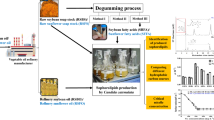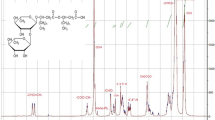Abstract
Soybean oil soapstock was utilized as an alternative carbon source for the production of rhamnolipids by Pseudomonas aeruginosa LBI strain. The chemical composition and properties of the rhamnolipid mixture obtained were determined to define its potential applications. The chemical characterization of the rhamnolipid has revealed the presence of ten different homologues. The monorhamnolipid RhaC10C10 and the dirhamnolipid Rha2C10C10 were the main components of the mixture that showed predominance of 44% and 29%, respectively, after 144-h of cultivation. The biosurfactant was able to form stable emulsions with several hydrocarbons and showed excellent emulsification for soybean oil and chicken fat (100%). The rhamnolipid removed 67% of crude oil present in sand samples and presented antimicrobial activity against Bacillus cereus and Mucor miehei at 64 μg/mL and inhibition of Neurospora crassa, Staphylococcus aureus, and Micrococcus luteus at 256 μg/mL. The results demonstrated that the rhamnolipid produced in soybean oil soapstock can be useful in environmental and food industry applications.




Similar content being viewed by others
References
Nitschke, M., Costa, S. G. V. A. O., & Contiero, J. (2005). Biotechnology Progress, 21, 1593–1600.
Banat, I. M., Makkar, R. S., & Cameotra, S. S. (2000). Applied Microbiology and Biotechnology, 53, 495–508.
Singh, P., & Cameotra, S. S. (2004). Trends in Biotechnology, 22, 142–146.
Deleu, M., & Paquot, M. (2004). C.R Chimie, 7, 641–646.
Nitschke, M., & Costa, S. G. V. A. O. (2007). Trends in Food Science & Technology, 18, 252–259.
Mercade, M. E., & Manresa, M. A. (1994). Journal of the American Oil Chemists' Society, 71, 61–64.
Bednarski, W., Adamczak, M., Tomasik, J., & Plaszczyk, M. (2004). Bioresource Technology, 95, 15–18.
Shah, V., Jurjevic, M., & Badia, D. (2007). Biotechnology Progress, 23, 512–515.
Dubey, K., & Juwakar, A. (2001). W. J. Microbial Biotechnology, 17, 61–69.
Fox, S. L., & Bala, G. A. (2000). Bioresource Technology, 75, 235–240.
Nitschke, M., & Pastore, G. M. (2003). Applied Biochemistry and Biotechnology, 105–108, 295–301.
Benincasa, M., & Accorsini, F. R. (2008). Bioresource Technology, 99, 3843–3849.
Lang, S., & Wagner, F. (1987). In N. Kosaric & W. L. Cairns (Eds.), Biosurfactants and Biotechnology: Structure and properties of biosurfactants (pp. 21–45). New York: Marcel Dekker.
Guerra-Santos, L., Kapelli, O., & Fiechter, A. (1984). Applied and Environmental Microbiology, 48, 302–305.
Benincasa, M., Contiero, J., Manresa, A., & Moraes, I. O. (2002). Journal of Food Engineering, 54, 283–288.
Nitschke, M., Costa, S. G. V. A. O., Haddad, R., Gonçalves, L. A. G., Eberlin, M. N., & Contiero, J. (2005). Biotechnology Progress, 21, 1562–1566.
Robert, M., Mercade, M. E., Bosch, M. P., Parra, J. L., Espuny, M. J., Manresa, A., et al. (1989). Biotechnology Letters, 11, 871–874.
Chandrasekaran, E. V., & Bemiller, J. N. (1980). In L. Wrhiste & M. L. Wolfrom (Eds.), Methods in carbohydrate chemistry: constituent analysis of glycosaminoglycans (pp. 89–96). New York: Academic.
Itoh, S., Honda, H., Tomota, F., & Suzuki, T. (1971). Journal of Antibiotics, 24, 855–859.
Lowry, O. H., Rosebrought, N. J., Farr, A., & Randall, R. J. (1951). Journal of Biological Chemistry, 66, 265–274.
Eaton AD, Clesceri LS and Greenberg AE (1995). In: Standard methods for the examination of water and wastewater: nitrogen (nitrate) ultraviolet spectrophotometric screening method. American Public Health Association, Baltimore: United Book Press, Inc., pp. 4–85–4–86.
Reiling, H. E., Thanei-Wyss, U., Guerra-Santos, L. H., Hirt, R., Kappeli, O., & Fiechter, A. (1986). Applied and Environmental Microbiology, 51, 985–989.
Deziel, E. F., Lepine, F., Dennie, D., Boismenu, D., Mamer, A. O., & Villemur, R. (1999). Biochimica et Biophysica Acta, 1440, 244–252.
Urum, K., Pekdemir, T., & Çopur, M. (2004). Journal of College Interface Science, 276, 456–464.
Woods, G. L., & Washington, J. A. (1995). In P. R. Murray (Ed.), Manual of clinical microbiology: antibacterial susceptibility tests: dilution and disk diffusion methods (pp. 1327–1341). Washington: ASM.
Ochsner, U. A., Hembach, T., & Fiechter, A. (1995). Advances in Biochemical Engineering/Biotechnology, 53, 89–118.
Mata-Sandoval, J. C., Karns, J., & Torrents, A. (2001). Microbiological Research, 155, 249–256.
Benincasa, M., Abalos, A., Oliveira, I., & Manresa, A. (2004). Anton Leeuw Int J G, 85, 1–8.
Urum, K., & Pekdemir, T. (2004). Chemosphere, 57, 1139–1150.
Abalos, A., Pinazo, A., Infante, M. R., Casals, M., García, F., & Manresa, A. (2001). Langmuir, 17, 1367–1371.
Haba, E., Abalos, A., Jauregui, O., Espuny, M. J., & Manresa, A. (2003). Journal of Surfactants and Detergents, 6, 155–161.
Acknowledgments
This work was supported by the Fundação de Amparo a Pesquisa do Estado de São Paulo (FAPESP). We thank Cargill S.A. for supplying the soybean oil soapstock and François Lépine and Sylvain Milot from Institut Armand-Frappier (Canada) for their help on structural characterization of rhamnolipids.
Author information
Authors and Affiliations
Corresponding author
Rights and permissions
About this article
Cite this article
Nitschke, M., Costa, S.G.V.A.O. & Contiero, J. Structure and Applications of a Rhamnolipid Surfactant Produced in Soybean Oil Waste. Appl Biochem Biotechnol 160, 2066–2074 (2010). https://doi.org/10.1007/s12010-009-8707-8
Received:
Accepted:
Published:
Issue Date:
DOI: https://doi.org/10.1007/s12010-009-8707-8




